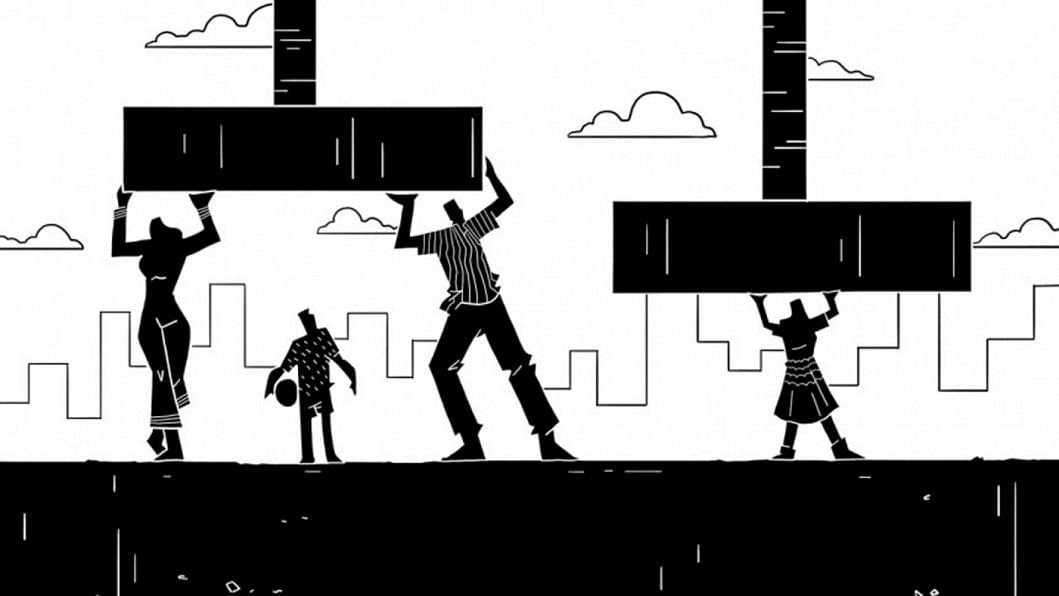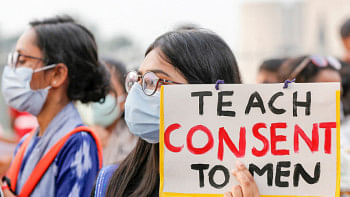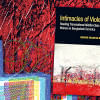‘No one says anything to a modest girl’

"It (sexual harassment) happens to those who have more fun, who move about outside more; it usually happens with them more. Girls should usually just calmly move about and not be engaging in excess socialisation. No one says anything to a modest girl."
This statement from a 13-year-old girl from a rural part of Chattogram district is concerning, but unfortunately not surprising. It is a harsh reminder of the sad reality in Bangladesh, where the complex landscape of sexual harassment of girls and women is plagued by a culture of victim-blaming, and girls and women are instructed to be modest to avoid unwanted attention or harassment. Unfair expectations are often placed on girls, limiting their mobility and discouraging "risky" behaviour. They are urged to be polite and avoid "excessive" socialisation.
Despite progress in many areas, sexual and reproductive health and rights (SRHR) for adolescents in Bangladesh, especially sexual and reproductive rights for girls, remain a major challenge. Social norms, patriarchal attitudes, a lack of comprehensive sex education, and access to services create barriers for young women seeking accurate SRHR information and care. This article delves deeper into the often-overlooked world of SRHR and adolescents in the urban and rural settings of Chattogram and Sylhet, exploring the ways in which societal expectations and cultural norms can impact young people's SRHR, including their choices about their bodies, relationships, and futures.
As part of the GAGE mixed methods baseline study, we spoke to 76 adolescents (38 boys, 38 girls) attending Classes 7 and 8 in 20 public and semi-private (MPO/non-MPO/madrasa) schools from urban and rural districts in Chattogram and Sylhet divisions during the Covid-19 closures in August-September 2020. We tried to understand how experiences related to bodily integrity, freedom from violence, sexual and reproductive health, health and nutrition, psychosocial well-being, voice and agency, and economic empowerment impact and shape the adolescents' transition from childhood to adulthood. The semi-structured interviews were virtual and telephone-based and used interactive qualitative tools. The adolescents were purposely selected from the GAGE quantitative baseline survey sample list. We also spoke to 11 parents of adolescents and 13 teachers to have a more in-depth understanding of their lived realities. See this report for details on the sampling and tools.
During interviews with adolescent girls from rural areas, many reported being victims of sexual harassment on the streets while commuting to and from school. They shared several ways that boys commonly known as "bokhate chhele" use to harass girls on the streets, including following them, catcalling, throwing flowers, etc. While discussing this topic, both boys and girls used the term "eve-teasing," synonymous to sexual harassment and, according to them, it impacted adolescent girls' school attendance. A 16-year-old boy from the rural areas of Chattogram said, "Boys tease girls when they are on their way to school, and the girls don't tell anyone about it. Then the girls don't attend school for two or three days because they are traumatised."
Boys will be boys?
It is important to understand the socio-cultural influences that shape these adolescents' understanding of the term "eve-teasing." Male adolescents, mostly from rural areas, mentioned that boys eve-tease pretty girls on the road because they are attracted to them and may want to marry them in the future. Therefore, this kind of harassment is perceived as the first step to a potential courtship. A 13-year-old girl from a rural area of Sylhet shared a similar perception; she also referred to the term "eve-teasing" and described it as a common practice that boys usually engage in as an effective romantic pursuit. The following quote shows how the media representation of boys teasing girls on the road to initiate a romantic relationship shaped her perception, "Maybe the boy likes the girl. The girl is very beautiful. Sometimes I see in the movies that when a boy likes a girl, he disturbs her."
Eve-teasing is a common term used in South Asian countries for sexual harassment that usually occurs in public places. It is a common term used in public and official discourse in Bangladesh. The word "teasing" is used for an activity that is playful which can be true for male adolescents in the abovementioned instances. However, it was unacceptable for female adolescents, as they mentioned being "in fear" as the recipient of such behaviour. Indian sociologist Pratiksha Baxi described eve-teasing as a culturally sanctioned and normalised practice that increases violence against women in public spaces, which is "a means to legitimise harassment by positioning the very presence of women in public as provocative." The word originates from the name of "Eve," who is known as a seductress, which implies that the female victim of harassment is the seductress and provokes the act of harassment, which promotes the culture of victim-blaming. Though some adolescents stated that perpetrators are solely responsible for their acts regarding sexual harassment, others shared similar thoughts while discussing the possible reasons behind sexual harassment. Some respondents, both male and female, mentioned girls being outgoing and having male friends as contributing factors for them being harassed.
It is a natural thing for boys to tease. It's like whenever they see a girl, they think, 'Let me tease her, let me talk to her, maybe then I will feel good…' I do think it is a typical habit of boys.
It was also mentioned by some respondents, both male and female, that girls should dress up modestly to avoid unwanted attention in the streets. They also mentioned the importance of "purdah" and following the traditional Islamic rules of dressing for women to avoid sexual violence. Though most of these respondents were studying in madrasas, we cannot conclude that these perceptions were shaped by the religious curriculum taught in their institutions. Rather, the fact that some adolescents attending general schools also had similar perceptions shows the dominance of patriarchy and rigid gender norms that shaped the mind of these young people of our country. A 15-year-old boy from the urban areas of Chattogram said, "Girls must take precautions to protect themselves and do 'purdah' [to cover oneself appropriately in accordance with Sharia law]. If they catch the eye of some wayward (bokhate) boys, they might even get raped. So, they should be careful not to put themselves in a position where they will be exposed to such unwelcome attention. Then no one can blame her even if boys do tease her."
The conversations with adolescents also brought up some other stereotypes related to sexual harassment committed by men, which shed light on their idea of the traditional perception of manhood. Two female respondents thought teasing girls was the "nature of boys." One of them, a 13-year-old girl from the urban areas of Sylhet, said, "It is a natural thing for boys to tease. It's like whenever they see a girl, they think, 'Let me tease her, let me talk to her, maybe then I will feel good…' I do think it is a typical habit of boys."
Another 14-year-old boy from urban Chattogram shared how boys his age get involved in risky behaviour to impress others and establish stereotypical masculine identities within their circles. He said, "Some of the boys of our age consider themselves playboys. At this age, they form gangs, they try to enhance their street credentials hoping everyone will be in awe of them. They want to create such an atmosphere. They want the entire community to fear them. Those with this mentality often indulge in such activities (sexual harassment)."

Too afraid to seek help
When it comes to addressing sexual harassment, both boys and girls felt that this kind of incident should be reported to the parents or teachers; otherwise, no actions will be taken, putting the victim in even more danger as the perpetrator may think there is no consequence for harassing girls. However, underreporting of harassment was also found: some respondents said although they had experienced sexual harassment, they had not reported it to anyone. One of the reasons that girls mentioned for not reporting is fear of being defamed. "If a victim reports such an incident, they (teachers-parents) may think of her as a girl of questionable morals," said a 13-year-old girl from a rural area of Sylhet.
Another 13-year-old girl from rural Chattogram shared her experience of getting teased and how she tried to convince the harassers not to, asking them to consider her as their little sister. She mentioned that the boys apologised to her after that. She felt it is always better to speak with the boys who harass them instead of complaining about them to the teachers; if they find out that the girl complained, the situation can get worse.
"When some female friends or other people don't explain to the boys directly but complain [to teachers at school], it escalates. If I don't complain to Sir [teacher], but rather make them [the harassers] understand, then it is better. I told one of my friends, 'Instead of complaining to Sir, make them understand.' Because they get angrier if we complain [to teachers] and they try to do more harm. They complained to sir and... afterward, he [the harasser] did exactly the same thing. He started teasing her again. So it doesn't decrease. They [boys] get beaten up, okay, but it doesn't decrease."
The fear of getting sexually harassed on the way to and from school can demotivate adolescent girls to continue their education. Different research findings show that sexual harassment is one of the main factors for girls dropping out of school, which eventually leads to early (child) marriage for most of them.
SRHR and menstrual health
There is a lack of knowledge on sexual and reproductive health and rights (SRHR), which is why the understanding of puberty among adolescents is very limited, i.e. changing voice, getting acne, and feeling shy. The topic of menstruation is associated with shame and stigma. There is no formal SRHR education given at the school. Adolescent girls learn about menstruation from their mothers, sisters or other family members, sometimes leading to misconceptions. "My mother doesn't allow me to go out for seven days [during my menstruation]. She says if I go out, the flow will increase," said a 14-year-old girl from a rural area of Chattogram.
Another challenge adolescent girls face that limits their scope in continuing education is menstrual hygiene management. Different government and non-government organisations (NGOs) have been working on menstrual hygiene management in urban and rural areas for decades. However, adolescent girls reported that their schools do not have proper facilities for menstrual management, such as availability of sanitary napkins, clean and well-maintained separate bathrooms, etc. As a result, many girls refrain from going to school during menstruation.
"[I think] there should be a madam designated for [distributing sanitary napkins] because this can happen any time. Plus, our bathrooms are in no fit state. They stink [and not cleaned everyday]. There is only one bathroom for girls. Actually, there are two latrines and one bathroom inside the enclosure. They are so dirty that you don't feel like entering them. I don't ever go to the bathroom," stated a 13-year-old girl from rural Sylhet.
My mother doesn't allow me to go out for seven days [during my menstruation]. She says if I go out, the flow will increase.
Child marriage
When we spoke to the parents, they mentioned their worries and insecurities regarding their daughters' safety, which is one reason why they tend to marry their daughters off at an early age. Most of the adolescents we spoke to were aware and well-informed about what constitutes child marriage and the minimum legal age of marriage. However, adolescents, especially some male respondents from rural areas, reported incidences of early/child marriage in their community. Most adolescents also knew the consequences and risks associated with early marriage. Most of them, regardless of gender, mentioned the risk of death during childbirth and premature infant birth as a result of child marriage. Some identified various impacts of child marriage on a girl, such as discontinuation of education, loss of voice and agency, domestic violence, and poor mental health. In line with the adolescents, some of the school teachers have also shared incidents of early marriage in their communities and how a girl's dream and hope of going for higher studies are shattered because of it. A few of them, on the other hand, mentioned witnessing attempted child marriages that were prevented with the help of police intervention and backlash from the community.
Early marriage is seen as a factor that would reduce the voice and agency of adolescent girls. In our conversation with the adolescents, most of them stated that girls would be unable to continue their studies after marriage even if they wanted to. A 13-year-old girl said, "In most cases, they [child brides] can't continue their studies. Only the lucky ones get to continue their studies. Sometimes, their husbands don't let them continue their studies. And in some cases, the husbands allow them, but the in-laws don't allow them to continue their studies."
A 14-year-old boy from an urban area of Sylhet shared an incident he witnessed, "Yes, such an incident happened in our school, in Class 10. She was forced to get married. After getting married, she wasn't allowed to come to school anymore."
Those who are lucky enough to continue their education after marriage, however, must abide by all the decisions made by their husbands and in-laws. Moreover, for those husbands and in-laws who allow their wives and daughters-in-law to continue education, it is considered to be a shameful act and disregard to the traditional social values. Sometimes, the married girl would be ridiculed for continuing her studies.
Another 13-year-old from Chattogram explained how early marriage impacts a girl's economic independence, "If a girl marries after the age of 18 or after getting established, she can live and think independently. But at 16 or 17, they aren't educated, nor can they work much. So, if they need something at this age, they have to seek support, like "I need this much money.'"
Findings reveal that most of the respondents felt seeking help and support from elders or influential community members to prevent child/early marriage would be helpful as adolescents themselves generally do not have the space and scope to share their opinion regarding marriage, which is commonly considered as an adult matter. On the other hand, a few adolescents mentioned that girls need to be more outspoken and assertive about their rights and raise their voices against child marriage.
To reduce dropout rates for married adolescent girls, schools should have a flexible structure so that they can continue their education. It is also important to combat sexual harassment in schools and on the way to and from school. This will help adolescent girls continue their studies without being subjected to harassment, and their parents would feel less concerned about their daughters' safety. This would eventually help to reduce the dropouts because of the fear of sexual violence.
Educational institutions should follow the High Court directives for establishing anti-sexual harassment committees and adolescents should be made aware of them. Menstrual hygiene management facilities at schools, especially in rural areas, need to be prioritised and maintained properly. Along with that, proper and comprehensive SRHR education needs to be taught at school, including topics such as puberty, social construct of gender, consent, unwanted pregnancy, etc.
This article draws on the qualitative findings collected for the mixed-methods baseline study, part of the Gender and Adolescence: Global Evidence (GAGE) multi-year impact evaluation linked to the Government of Bangladesh's (GOB) Adolescent Student Programme (ASP), implemented by the Ministry of Education with support from the Ministry of Health. It is linked to the ongoing World Bank support to Bangladesh through the Transforming Secondary Education for Results. The qualitative baseline study was done by GAGE Bangladesh qualitative research team based at the Brac James P Grant School of Public Health (JPGSPH) and the Brac Institute for Governance and Development (BIGD).
Farhana Alam is a qualitative researcher for GAGE Bangladesh research team from the Brac James P Grant School of Public Health, Brac University.

 For all latest news, follow The Daily Star's Google News channel.
For all latest news, follow The Daily Star's Google News channel. 












Comments